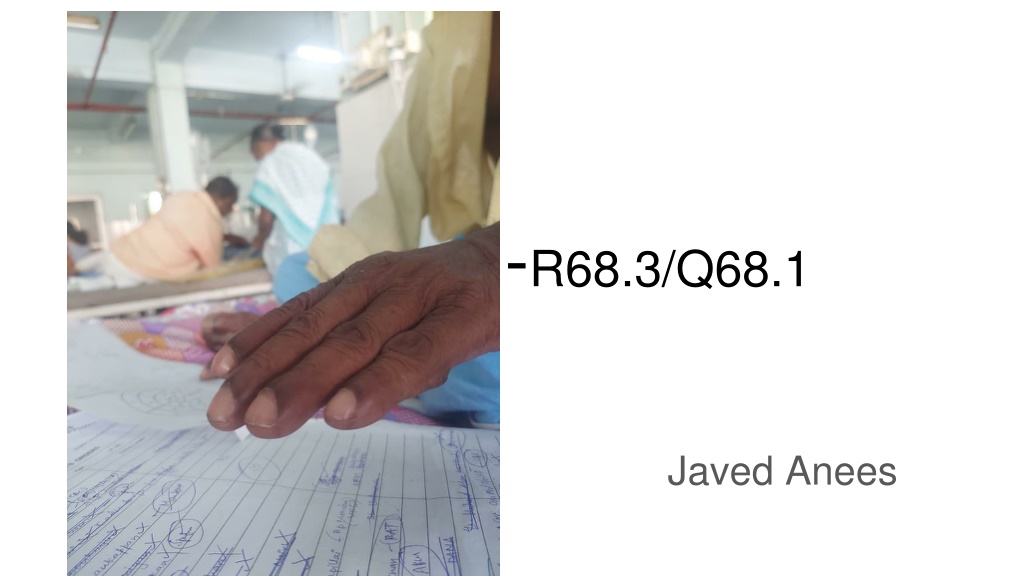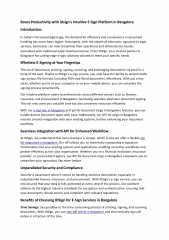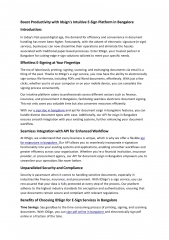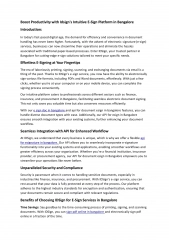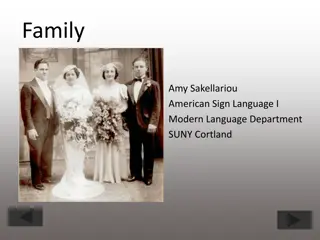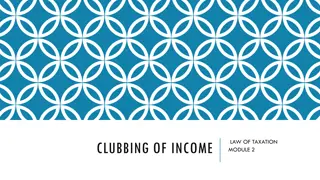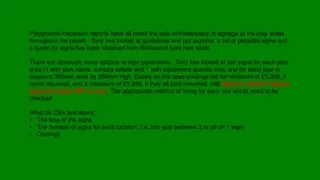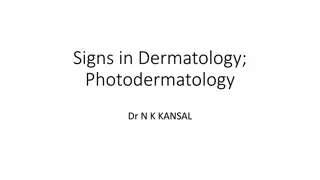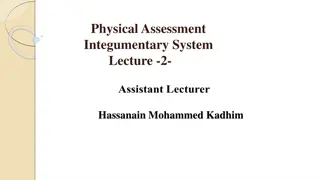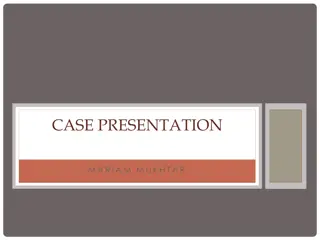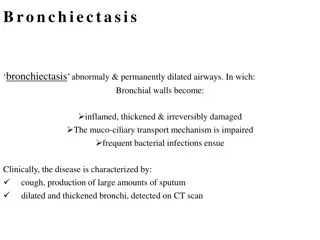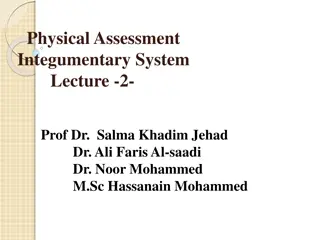Understanding Clubbing: A Physical Sign of Underlying Health Conditions
Clubbing is a physical sign characterized by the bulbous enlargement of fingers or toes. It is usually painless and bilateral, often unnoticed by the individual. Early detection is crucial as clubbing can indicate serious underlying health issues. Signs of early clubbing include the "floating nail" and "profile" signs, which involve changes in the angle between the nail plate and skin. Distinguishing clubbing from other fingertip abnormalities is essential for accurate diagnosis.
Download Presentation

Please find below an Image/Link to download the presentation.
The content on the website is provided AS IS for your information and personal use only. It may not be sold, licensed, or shared on other websites without obtaining consent from the author. Download presentation by click this link. If you encounter any issues during the download, it is possible that the publisher has removed the file from their server.
E N D
Presentation Transcript
Clubbing-R68.3/Q68.1 Javed Anees
Physical sign characterized by bulbous enlargement of the ends of one or more fingers or toes Proliferation and edema of connective tissue result in loss of the normal angle between the skin and nail plate and excessive sponginess of the nail base usually acquired
Clubbing is usually painless and bilateral. The patient may be unaware of the gradual enlargement of fingertips or toes until it is brought to his or her attention. Patients with hereditary clubbing may report a family history of clubbing or a long duration of clubbing without any symptoms or signs to suggest an underlying illness. In acute cases, the more rapid onset or mild associated discomfort may draw attention to the deformity. It is important to detect early clubbing because clubbing can be the first clue to a serious underlying disorder that, if treated early, may be curable.
Signs of early clubbing "floating nail" sign: Normally, the root of the nail plate lies snugly against the bone of the distal phalanx; pressure on the root produces no movement. With clubbing, the root is separated from bone by connective tissue and edema; pressure upon the nail plate moves it toward the bone. The base of the nail becomes resilient and springy, and the nail feels as if it is floating on a cushion. As clubbing progresses, the nail becomes loosely attached, and the free edge of the nail plate may become visible or palpable as a horizontal ridge over the dorsal aspect of the finger.
"Profile" sign: Normally, the angle between the nail plate and the skin overlying the proximal part of the distal phalanx is about 160 degrees or less. With clubbing, proliferation of tissue under the nail plate causes this angle to increase to more than 160 degrees. In fact, the angle may be entirely lost and the nail plate and skin lie in a straight line (180- degree angle). As clubbing progresses, the angle exceeds 180 degrees. Eventually, the profile of the fingertip becomes bulbous.
Early clubbing must be distinguished from several other abnormalities of the fingertip. These include: (1) increased nail curvature, a normal finding in many adults (especially blacks); (2) chronic paronychia, in which the soft tissue at the base of the nail is inflammed and swollen; (3) felons or abscesses of the terminal pulp space, in which there is swelling over the palmar surface of the fingertip. The fundamental angle between nail and terminal phalanx not altered in these conditions
Schamroth- readily differentiates true clubbing from these pseudo-clubbing conditions. The examiner asks the patient to hold the two thumbs back to back with the two fingertips and interphalangeal joints aligned. Because the base angle is unaltered in these conditions, an elongated, diamond-shaped area of empty space is apparent. In true clubbing, this empty space is lost. Schamroths window,Schamroths sign,Schamroths angle Sensitivity-77-87%,Specificity-90% (Pallares-Sanmartin etal-2010)
40% Clubbing associated with serious underlying disease. In addition, because clubbing may precede any other evidence of the underlying disorder, it may serve as the only clue to an otherwise silent lesion. Review of the literature indicates that between 75 and 80% of clubbing are associated with chronic pulmonary diseases; 10 to 15% are associated with cardiovascular diseases; 5 to 10% with chronic hepatic and gastrointestinal disorders; and 5 to 10% with miscellaneous disorders.
Unilateral clubbing - associated with hemiplegia and vascular lesions Bilateral clubbing - associated with neoplastic, pulmonary, cardiac, gastrointestinal,infectious, endocrine, vascular and multisystemic disease Clubbing involving a single digit: Pseudoclubbing should be ruled out.
History taking in Clubbing A person with clubbing often has symptoms of another condition. So we need to take- Family history Medical history Physical exam that looks at the lungs and chest
Questions asked? eg: Do you have trouble breathing Do you have clubbing of fingers,toes or both When did you first notice this?Do you thing its getting worse? Does the skin ever have a blue colour? What other symptoms do you have?
Tests may be done Eg: CBC ESR,RFT,LFT,SE ABG CXR CT Chest ECG ECHO PFT
Hypertrophic Osteoarthropathy Always be sought for if clubbing+ Severe, burning, deep pain over the distal extremities, especially of the legs, that is worsened at night and on dependency. Early cases, the examiner may note warmth, reddening, or brawny edema of the skin over the distal long bones (particularly over the shins). In acute or severe cases, there may be exquisite tenderness of the feet and legs and the hands and forearms, and tenderness and effusions of the adjacent joints (the ankles, knees, wrists, and fingers). The examiner may elicit tenderness over bony prominences by simply pressing or by encircling the limb (e.g., the wrist) with his own fingers like a bracelet and gently squeezing it. Later, autonomic changes such as flushing, sweating, or blanching (Raynaud's phenomenon) may be noted in the affected hands and feet.
Pachydermoperiostosis Most often complain about their changing appearance or the excessive perspiration, especially of the hands and feet. Active phase- they may have mild bone pain or arthralgia. Later- clumsiness of fingers, ptosis from thickening of the skin over their eyelids, or facial palsy from thickening of the skull. O/E Clubbing of the fingers and toes, accompanied by "spadelike" or "pawlike" enlargement of the hands and feet; joint effusions may be present. Skin changes- excessive sweating, generalized thickening (called pachyderma) and redundancy, especially over the forehead and scalp, leading to characteristic "bulldog" furrowing (cutis verticis gyrata) and leonine facies, sometimes mistaken for leprosy.
Further Evaluation In all three conditions (i.e., clubbing, hypertrophic osteoarthropathy, and pachydermoperiostosis), the physician should specifically examine for findings of associated illness. including wheezes, rales, pleural effusion, supraclavicular adenopathy, cardiac murmurs, Roth spots, peripheral stigmata of endocarditis, splenomegaly, jaundice, vascular angiomata, palmar erythema, hepatomegaly, abdominal mass (suggesting regional enteritis), thyromegaly, and ophthalmopathy.
Xrays in clubbing: Clubbing may be a manifestation of either hypertrophic osteoarthropathy or pachydermoperiostosis, the clinician may want to obtain x-rays of the distal extremities. In early clubbing, x-rays will be normal except for increased soft tissue. In the later stages, there may be fraying of the edges of the distal phalanx, followed by gradual resorption of the bone (acro-osteolysis).
X-rays in hypertrophic osteoarthropathy: symmetrical, irregular periosteal proliferation, calcification and new bone formation (periostitis) over the distal arms and legs, or acro- osteolysis of the distal phalanges of fingers and toes.
The finding that 99m-technetium pyrophosphate bone scans are more sensitive than plain x-rays in detecting early periostitis can be helpful in difficult cases. In advanced cases of osteoarthropathy, and in pachydermoperiostosis, x-rays may show extreme degrees of periostitis in almost any bone, although the skull, vertebrae, and articular surfaces are usually spared.
Theories Arterial Hypoxaemia-Humoral PDGF-VEGF Vagal stimulation
Pulmonary disease is the most common cause Primary or secondary malignancy of the bronchus or lung, as well as tumors of the pleura, mediastinum, thymus, and chest wall, are perhaps the most worrisome associations. But a variety of chronic pulmonary infections, including lung abscess, chronic empyema, pneumoconiosis, chronic pneumonitis, cystic fibrosis, emphysema with chronic suppuration, actinomycosis, and bronchiectasis, can also produce the characteristic picture. More rarely, it has been described in patients with chest deformities, aortic aneurysm with compression of lung, and neurogenic tumors of the diaphragm.
Conditions Associated with Clubbing Pulmonary disease: Bronchiectasis. Lung abscess. Bronchogenic carcinoma. Empyema thoracis. Fibrosing alveolitis. Pleural mesothelioma. Pulmonary arteriovenous fistula. Cystic fibrosis. Thymoma Metastatic Ca Pneumoconiosis Chronic pneumonitis Cystic Fibrosis Neurogenic tumours of diaphragm
Pulmonary tuberculosis & clubbing Uncommon in uncomplicated pulmonary tuberculosis Occur in up to 25% of cases with supervening bronchiectasis or chronic cavitation. causes: Post tuberculous bronchiectasis Diffuse B/L lung fibrosis Empyema
Cardiovascular cause of clubbing Infective endocarditis Cyanotic CHD Myxoma of atria Aneurysm of major vessels such as aorta and subclavian artery Cor Pulmonale Secondary Polycythemia Congestive cardiac failure Pulmonary AV Fistula Arterial Graft rejection
Gastrointestinal Malabsorption IBD -Crohn's, ulcerative colitis,Regional enteritis Cirrhosis of liver particularly biliary cirrhosis Chronic Infection Ascariasis,Malaria,Intestinal TB Chronic Amoebic Dysentery Sprue
GastroIntestinal- Hepatic: Cirrhosis (all types) Amoebic abscess Amyloidosis
Gastro Intestinal: Neoplasm Intestinal polyposis Abdominal lymphoma Nasopharyngeal carcinoma Esophageal carcinoma Gastric carcinoma Colonic carcinoma
Miscellaneous Endocrine conditions,Hyperthyroidism,Hyperparathyroidism Pregnancy,Chronic infections,Chronic osteomyelitis with amyloidosis Chronic pyelonephritis, Congenital disorders: Muscular dystrophy,hemoglobinopathies Idiopathic disorders: Chronic mountain sickness,Syringomyelia, Neoplasms: Renal carcinoma, Chronic myelocytic leukemia Toxin exposure:Arsenic, Mercury,Silica,Beryllium,Phosphorus, Alcohol,Chronic laxative abuse
Asymmetrical Clubbing: Unilateral: Anomalous aortic arch, Aortic or subclavian artery aneurysm, Pulmonary hypertension with patent ductus arteriosus Brachial arteriovenous aneurysm or fistula, Recurrent shoulder dislocation, Superior sulcus (Pancoast) tumor Unidigital: Hereditary, Trauma,Median nerve injury, Sarcoidosis,Gout,Idiopathic, digital mucoid cyst, osteoid osteoma and myxochondroma
What are the different types of clubbing? Drum stick type of clubbing : Congenital cyanotic heart diseases, e.g. Fallot's tetralogy. Bronchiectasis. Parrot-beak type of clubbing : Commonly seen in bronchogenic carcinoma.
Painful clubbing Bronchogenic carcinoma. SBE.
Think of.. Clubbing limited to upper extremity:- Chronic obstructive phlebitis of upper extremity as a result of chronic I.V drug addiction (eg. heroin). Clubbing limited to lower extremity:- infected abdominal aortic aneurysm : COA,sometimes in PDA with reversal of shunt. Acute clubbing:- Development of clubbing within 10 to 14 days of onset of illness-lung abscess
Pseudoclubbing? Seen in conditions associated with subperiosteal bone resorption of terminal phalanges. Here there is absence of soft tissue proliferation and increased curvature of nails and is seen in. Scleroderma. Acromegaly. Hyperparathyroidism. Leprosy.
